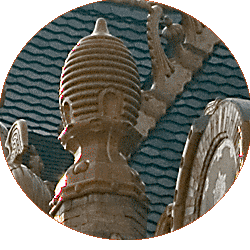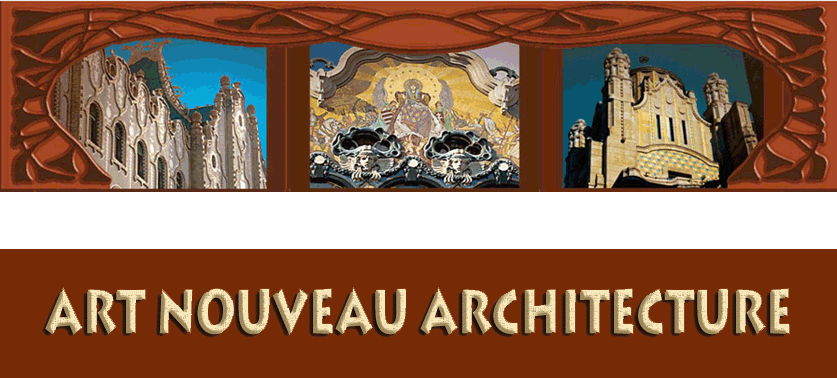
A Postatakarékpénztár oromzata.
A volt Magyar Királyi Postatakarékpénztár épülete.
Budapest, V. kerület, Hold utca 4. Jelenleg a Magyar Államkincstár működik benne.
Épült: 1900-1901.
Tervezte:
Lechner Ödön és Baumgarten Sándor
A Postatakarékpénztár Lechner leginkább megcsodált épülete, építészeti pályája
csúcsát jelenti, azé a Lecheré, aki itt valósította leginkább kitűzőtt célját,
a magyar építészeti stílus megteremtését.
Lechner úgy vált a magyar szecessziós
építészet, a magyar építészet vezető egyéniségévé, hogy a régi stílusokról nem
szólt támadólag, a szecessziót, az előző századtól való elszakadást nem hirdette,
de megtette.
Ennek a hajdan kispénzű emberek bankjaként müködő épületnek belső térfelosztása és berendezése
is ugyanigy csodálat tárgya lehetne, sajnos eredeti funkcióját elvesztette,
belsője pedig még felújításra vár, a reményteljes igéret viszont megvan hozzá.
Az itt jelenlevő szövegek - célírányosan - a képen látható részletekkel foglalkoznak.
Vidd az egeret a kép felé, a megjelölt részek felé, hogy a részinformációk megjelenjenek.
A Postatakarékpénztár oromzata.
A toronytető és díszei

A tetődíszen látható bikafejek esetében Lechner a magyar ill. hun eredetűnek hitt
aranylelet, a nagyszentmiklósi kincs bikafejes ivóedényeiből indult ki, tisztelegve
a múltból származó értékeink előtt. Ahogy ezt a harmonikus tetődíszt összeségében kialakította,
páratlan szépségű. Összehozta a szecesszió mozgalmasságát és a klasszikus egyensúlyt.
Sikeressége ugyanakkor a Lechner - Zsolnay baráti együttműködés eredménye is.
Lásd még magazin 3.számában a
A nagyszentmiklósi kincs a Lechner és Zsolnay művekben cikket
A Postatakarékpénztár oromzata.
A méhkas szimbólum

A méhkas formát Lechner ragyogó ötlettel mint pillérfőt alkalmazza, persze
nem öncélú formaként, hanem a takarékosság, a gyűjtögetés banki szimbólumaként.
A pilléren lentebb látható (más részletképünkön pedig még nagyításban is) méhek sorakoznak
felfele amint gyüjtésükből hazatérve a méhkas fele igyekeznek.
A Postatakarékpénztár oromzata.
Róth Miksa a mozaikról


"Midőn a Postatakarékpénztár palotája épült, hozzám fordult Lechner Ödön azzal a kérdéssel,
hogy tudnék-e - az eddig csak zárt és határozott felületeken alkalmazott mozaik helyett - vakolat-háttérbe
behelyezett szabadrajzú mozaik-disziteseket késziteni. A felvetett gondolatot magamávé tettem és sikerült
olyképpen megvalósitanom, hogy a mozaik-diszitést - mely látszólag a vakolat-háttérbe van elhelyezve -
attól függtelenül tartós anyagba beágyaztam, úgy, hogy amennyiben a vakolat idővel leromlanék,
a mozaik sértetlenül és szilárdan megmarad a helyén"
Róth Miksa - Egy üvegfestőművész az üvegfestészetről, Budapest, 1942
A Postatakarékpénztár oromzata.
A lechneri téglaszalagok


Akkor és most. Az épület akkor - egy ilyen nagyméretű középület esetében -
szokatlanul sikszerűnek tünt, még központi falsikja sem emelkedik ki. Ma, a modern épitészet ismeretében
ez már nem annyira feltűnő. Amit viszont ma is mindannyian csodálunk azok a lendületes-vonalas fali diszitőelemek, a
téglaszalagdiszek, Lechner sokak által követett találmánya.
Ami általános és szecessziós jellegű. A századvégi ill. századfordulós festészet és
ornamentika általános jellemzője volt a sikszerüség és a vonalakra épitő mozgalmas kompozició.
Lásd ezzel kapcsolatban cikkünk - A Nabik csoportja és Rippl-Rónai - 2011 / 2.szám
Ami viszont egyedi és sajátosan lechneri, azok a vonalas diszek formája amennyiben
Lechner azok megalkotásakor szem előtt tartotta a magyar népi diszitőművészet korában ismert
mintáit.
Ablakot bezár












 On May 26, we toasted for the 90 years old artist, Gyula Keresztes. We report the
event and introduce you to his book - `Marosvasarhely szecesszios epuletei`
(a book introducing you to the buildings in Marosvasarhely, inspired by secession) - ,
including a small instalment and few images of the Rado-haz (Rado house), where Ede
Thoroczkay-Weigand used to live.
On May 26, we toasted for the 90 years old artist, Gyula Keresztes. We report the
event and introduce you to his book - `Marosvasarhely szecesszios epuletei`
(a book introducing you to the buildings in Marosvasarhely, inspired by secession) - ,
including a small instalment and few images of the Rado-haz (Rado house), where Ede
Thoroczkay-Weigand used to live.













 On May 26, we toasted for the 90 years old artist, Gyula Keresztes. We report the
event and introduce you to his book - `Marosvasarhely szecesszios epuletei`
(a book introducing you to the buildings in Marosvasarhely, inspired by secession) - ,
including a small instalment and few images of the Rado-haz (Rado house), where Ede
Thoroczkay-Weigand used to live.
On May 26, we toasted for the 90 years old artist, Gyula Keresztes. We report the
event and introduce you to his book - `Marosvasarhely szecesszios epuletei`
(a book introducing you to the buildings in Marosvasarhely, inspired by secession) - ,
including a small instalment and few images of the Rado-haz (Rado house), where Ede
Thoroczkay-Weigand used to live.















